 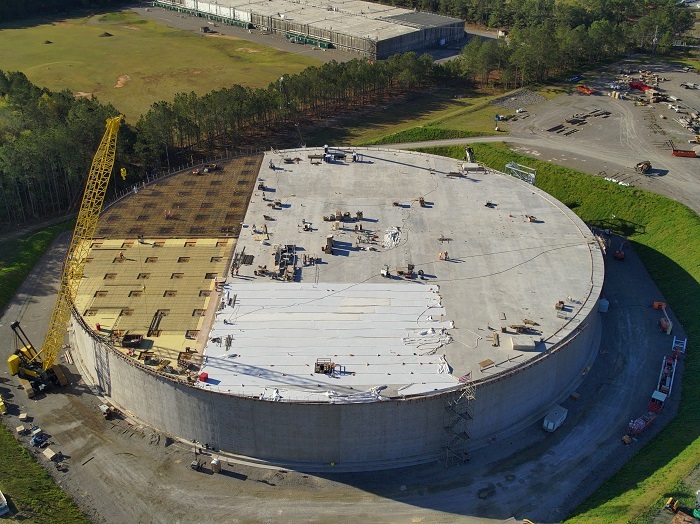 All major concrete placements have been completed on Saltstone Disposal Unit 10, the latest mega-size disposal unit being built at the Savannah River Site, bringing the U.S. Department of Energy Office of Environmental Management and contractor Savannah River Mission Completion a step closer to achieving the liquid waste mission. This aerial view shows the final roof section being installed on the unit.
AIKEN, S.C. — The U.S. Department of Energy Office of Environmental Management (EM) has attained another milestone in the construction of mega-size disposal units necessary to complete the cleanup program at the Savannah River Site (SRS).
With the placement of 25 wall sections, 208 support columns and seven roof sections, EM crews have completed all major concrete placements for Saltstone Disposal Unit (SDU) 10. When complete, SDU 10 will be the fifth mega-size unit built at SRS that can hold up to 33 million gallons of saltstone. More than 20,000 cubic yards of concrete is needed to build each SDU, using approximately 700,000 total labor hours.
Savannah River Mission Completion (SRMC), the SRS liquid waste contractor, manages the construction and operation of the SDUs. Constructing the large-scale disposal units is a priority for the cleanup program, and this milestone comes just weeks after SRMC received authorization to operate SDU 9.
Subcontractor DN Tanks completed the concrete construction, and Quality Plus Services completed the site preparation for the project.
Jim Folk, DOE-Savannah River assistant manager for waste disposition, said it has been affirming to witness the landscape change at SRS as the SDUs are built.
“Since the first mega-unit, SDU 6, was built in 2017, EM has not slowed down on construction of these critical structures,” Folk said. “These SDUs ensure that the decontaminated salt solution will have a place to be safely and permanently disposed of. Completion of the concrete placements for SDU 10 is another step forward on the mission to clean up the legacy radioactive waste at the Savannah River Site.”
The SDUs are the end of the salt waste processing path. The Salt Waste Processing Facility (SWPF) separates and concentrates the highly radioactive waste from the less radioactive salt waste, producing a decontaminated salt solution that is sent to the Saltstone Production Facility. There, the solution is mixed with dry materials to make a cement-like grout. The grout is pumped into the SDUs, where it solidifies into a monolithic, non-hazardous form.
The larger SDUs are designed to support the increased material from SWPF. The new SDUs result in more than $500 million in cost savings over the life of the SRS liquid waste program because they require less infrastructure and materials than the previously planned 80 smaller SDUs.
Next on the to-do list for SDU 10 is to wrap the unit with 341 miles of cable around the exterior walls. The cable in the unit walls ensures the structural integrity while grout is being added before it turns into hardened saltstone.
Work is also underway for the final pair of SDUs — 11 and 12 — adjacent to SDU 10. Mud mat installation for SDU 11 is scheduled to start later this summer, and the mud mat addition for SDU 12 is scheduled to begin in the fall. They provide a solid surface for the SDU concrete floor.
Dave Olson, SRMC president and program manager, said he is impressed and proud of the skilled work by the crews constructing SDU 10.
“Most importantly, this project is being completed safely, with no injuries that caused a missed day on the job,” Olson said. “The construction crews building the SDUs continuously prove themselves to be safety-focused and reliable, which are two important core values of Savannah River Mission Completion.”
-Contributor: Colleen Hart
 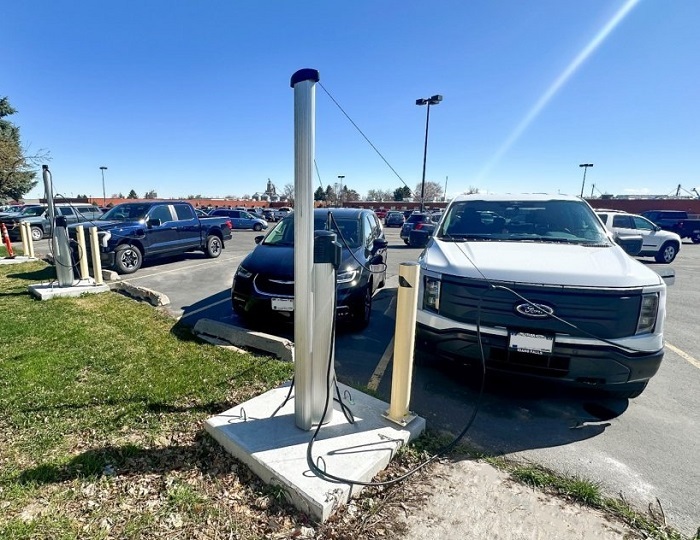 The Idaho Cleanup Project (ICP) is one of four U.S. Department of Energy Office of Environmental Management sites to receive the Department’s Fiscal Year 2024 Green Fleet Award. ICP has enlarged its electric vehicle fleet and installed charging stations at the Idaho National Laboratory (INL) Site. These upgrades, pictured, are part of ICP’s strategic effort to achieve environmental sustainability objectives for the INL Site.
WASHINGTON, D.C. — The U.S. Department of Energy (DOE) is honoring four sites within its Office of Environmental Management (EM) for their significant contributions toward a Biden administration goal of achieving a 100% zero-emissions vehicle fleet by 2035.
In recognition of their efforts toward a more sustainable DOE fleet, the Idaho Cleanup Project and Hanford, Paducah and Savannah River sites will each receive the Department’s Fiscal Year (FY) 2024 Green Fleet Award.
“EM sites have demonstrated outstanding leadership in helping the Department of Energy achieve the administration’s goal of transitioning to 100% zero-emission vehicles by 2035, with 100% light-duty vehicle acquisitions by 2027,” DOE Chief Sustainability Officer Ingrid Kolb said.
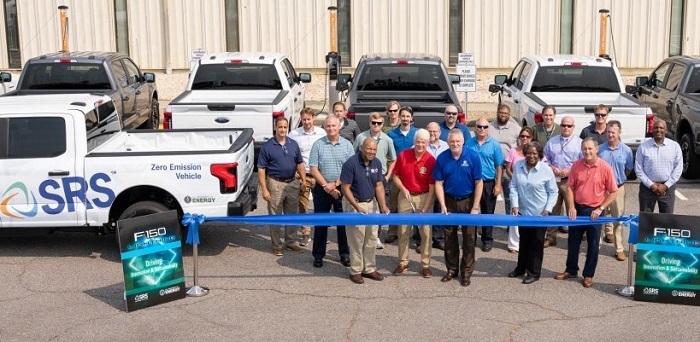 Officials cut a ribbon in a ceremony celebrating the addition of over 100 zero-emissions vehicles to the Savannah River Site vehicle fleet last year.
In FY 2024, the Paducah and Savannah River sites ordered 100% light-duty zero-emissions vehicles, while the Idaho Cleanup Project and Hanford ordered 90% and 84% light-duty zero-emissions vehicles, respectively.
In recognition of these achievements, each of the four sites will receive a portion of $1.05 million in grants from the DOE Office of Management to order additional zero-emissions vehicles and install electric vehicle charging infrastructure.
“The support for charging infrastructure will go a long way toward incentivizing continued effort by our sites,” EM Senior Advisor William “Ike” White said. "As the world’s largest environmental cleanup program, EM has a unique responsibility to lead by example.”
EM sites ordered 219 zero-emissions vehicles in FY 2024, accounting for 89% of DOE’s total orders, exceeding EM’s 2024 goal. EM sites also installed a total of 120 charging ports to date, with many more expected over the next few years.
-Contributor: Albes Gaona
 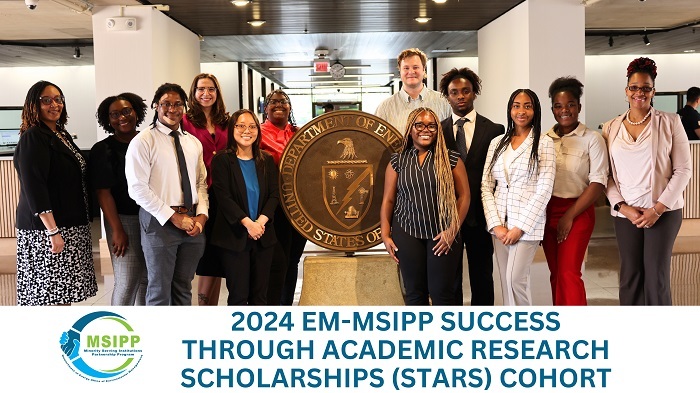 The Success Through Academic Research Scholarship (STARS) Scholars celebrate their first day with the U.S. Department of Energy Office of Environmental Management (EM). From left: EM STARS Program Manager Latrincy Bates, Darian Moulden, Tylin Williams, Hannah Newmarker, Lillian Ngohuynh, Aniya Ziegler, Evan Watkins, Marly Pierre, Emmanuel Otto, Tyler Mends, Xana Lee and EM Minority Serving Institutions Partnership Program Manager Genia McKinley.
WASHINGTON, D.C. — The U.S. Department of Energy Office of Environmental Management (EM) last week welcomed the first cohort of its Minority Serving Institutions Partnership Program (MSIPP) Success Through Academic Research Scholarship (STARS) Scholars.
The 10 students were selected to participate in a 10-week summer internship at sites across the EM complex. The Savannah River Site in Aiken, South Carolina, will host two scholars and the Portsmouth/Paducah Project Office in Lexington, Kentucky, will host eight scholars. At the conclusion of the internship, the interns will join other EM MSIPP participants at the 10th Annual EM MSIPP Achievement Award Workshop in Augusta, Georgia, to present their summer research.
The STARS Scholars spent last week at DOE headquarters, where they met EM leadership and staff and received training to prepare them for their future careers at EM. To kick off the week, they spent Monday learning about EM’s mission, history and future. EM Diversity Chief Dameone Ferguson and EM Pathways Program Manager Maurice Thompson with EM’s Workforce Management Office coached the scholars on EM’s Everyone Matters initiative and discussed resources and opportunities available to them during the two-year program. They also learned about generational diversity, gaining insight into working with people from different generations.
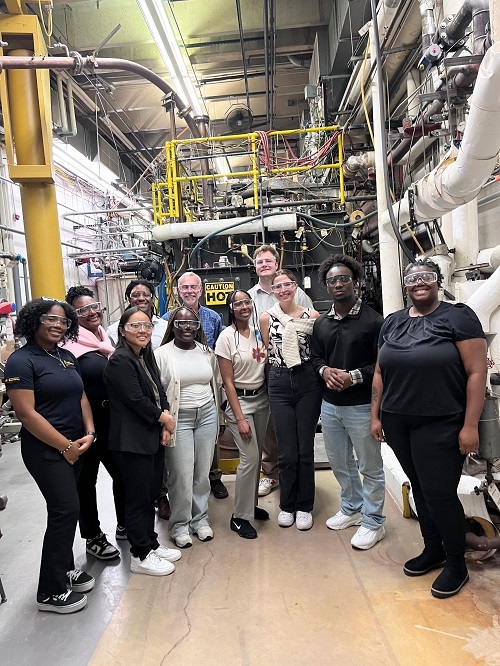 |
|
Success Through Academic Research Scholarship (STARS) Scholars are pictured with Vitreous State Laboratory Director Ian Pegg at one of laboratory’s pilot melters at The Catholic University of America. |
The STARS Scholars also met members of the EM headquarters staff, received training and learned about setting and working towards goals, among other things. At the end of the week they toured the Vitreous State Laboratory at The Catholic University of America with Ian Pegg, the laboratory’s director. The scholars viewed demonstrations of glass melting and pouring, and toured the laboratory’s pilot melters and off-gas treatment system. The day concluded with a tour of the laboratory’s analytical facilities.
The scholars began their assignments at their respective sites this week.
The STARS program is part of the larger EM MSIPP, which works to build a sustainable pipeline to employment with EM for students pursuing science, technology, engineering and math (STEM) degrees at minority serving institutions.
-Contributor: Lauren Zack
 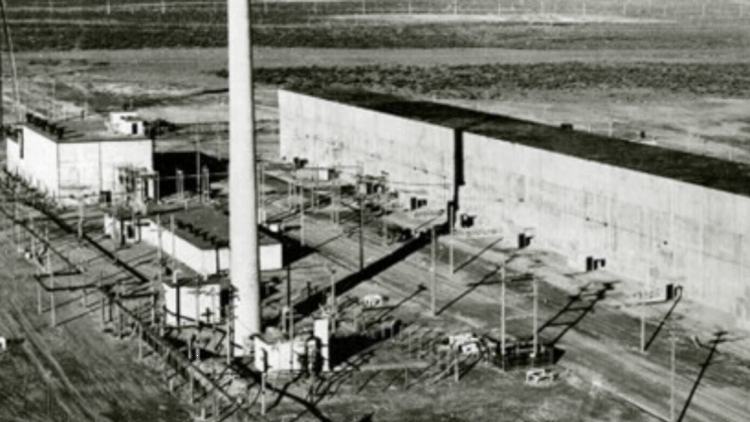 Among the most historic buildings at the Hanford Site, the T Plant was built to support the site's World War II-era mission. It became the world’s first full-scale reprocessing canyon, producing plutonium sent to a top-secret site in Los Alamos, New Mexico, for use in testing and weapons.
RICHLAND, Wash. — Photography of one of the most historic buildings at the Hanford Site is on its way to the Library of Congress as part of the U.S. Department of Energy’s participation in the nationwide Historic American Engineering Record (HAER) process.
Established in 1969 by the National Park Service, the American Society of Civil Engineers and the Library of Congress, the HAER documents historic sites and structures related to engineering and industry.
From steel bridges and railroads to facilities and structures, the HAER provides a detailed account of America’s historic engineering feats through large-format photography, final drawings and other information. These records are preserved in the Library of Congress and complement similar programs focused on architecture and landscapes.
When most people think about Hanford’s role in the Manhattan Project, it’s B Reactor that springs to mind. But T Plant was no less critical to the site’s success. Once irradiated inside the B Reactor, uranium fuel rods were taken by rail to T Plant to be dissolved in a series of chemical baths, finally resulting in the extraction of just a tiny bit of plutonium.
Three of these plants were built to support Hanford’s World War II-era mission. T Plant came online first, becoming the world’s first full-scale reprocessing canyon and producing the plutonium sent to a top-secret site in Los Alamos, New Mexico, for use in testing and weapons.
DOE Hanford’s National Park Program requested the completion of the HAER process, including the specialized photography.
“T Plant is no less historic than B Reactor,” said Colleen French, DOE’s National Park Program manager. “They are two big characters in the same important story. Like B Reactor, T Plant needs to be evaluated for National Historic Landmark status and could someday be included in updates to the Manhattan Project National Historical Park when Hanford’s cleanup mission is complete.”
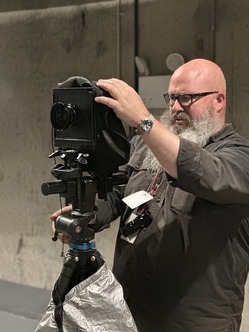 |
|
Harley Cowan prepares to photograph Hanford’s T Plant as part of the documentation process to add the facility to the Historic American Engineering Record. Constructed in 1944, T Plant remains the only World War II-era nuclear facility still operating with a current mission. |
Photographer Harley Cowan recently captured large-format black-and-white film images of the Hanford Site’s T Plant using a specialized Sinar camera. The high-quality photos will be maintained in a special collection at the Library of Congress as part of the Historic American Engineering Record. |
|
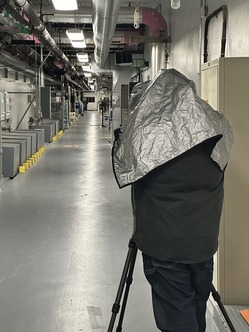 |
The documentation process for the HAER requires measured drawings that illustrate the structure’s functions and systems, detailed historical reports and large-format black-and-white photographs using film. Enter Harley Cowan, a Portland, Oregon-based photographer and architect who has made significant contributions to architectural heritage documentation and preservation through large-format black-and-white photography.
“While visually striking, this method is chosen for its high resolution and archival stability,” said Cowan. “The clarity and depth of detail captures images beyond what conventional photography can offer. It ensures the documentation of a structure’s engineering can be preserved.”
An expert in his field, Cowan has completed work included in the Historic American Buildings Survey Collection at the Library of Congress, and he has been recognized with numerous accolades. He was inducted into the Atomic Photographers Guild in 2019 for his documentation of the B Reactor and the Manhattan Project.
Cowan spent a week in May capturing the nuances of T Plant using a Sinar camera, which is known for its high-quality formatting. The process of large-format photography is like that of the early 1900s, though the equipment is better. Cowan uses a large, tripod-mounted camera with a dark cloth, or hood, to block out light. He focuses the image with a ground glass screen that displays the scene upside down and manually sets exposure times.
“It’s not as easy as ‘point and shoot,’” said Cowan. “Architectural photographs are a science.”
See some of Cowan’s photographs documenting other Manhattan Project sites.
 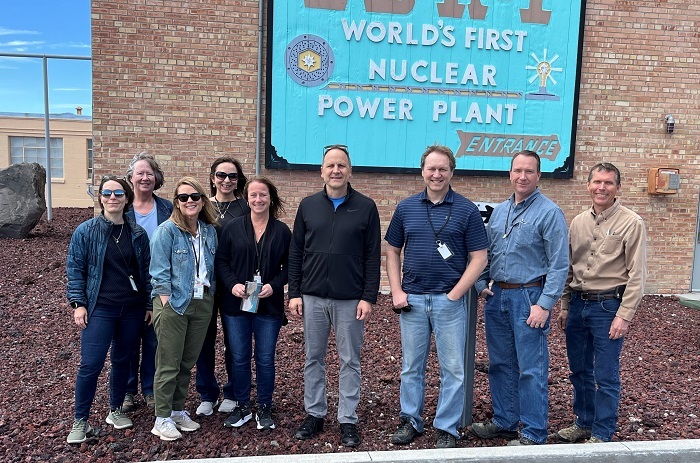 Pictured are participants touring the Idaho Cleanup Project, which was part of the Atomic Energy of Canada Limited (AECL) visit. From left: Maude-Émilie Pagé, director, GoCo Procurement and Contract Renewal Strategy, AECL; Linda Montgomery, consultant to AECL; Geri Dean, manager, Procurement, Contract & HR, AECL; Cindy O’Leary, legal counsel, AECL; Eleanor Miller, program coordinator, AECL; David Hess, senior procurement and contracting executive, AECL; Craig Michaluk, senior director, Program & Technical Review, AECL; Doug Pruitt, assistant manager, Environment and Waste Management, U.S. Department of Energy Office of Environmental Management (EM); Mark Jones, executive officer, EM.
As part of the U.S. Department of Energy (DOE) Office of Environmental Management’s (EM) bilateral agreement and ongoing collaboration with Canada's Atomic Energy of Canada Limited (AECL), EM headquarters facilitated an AECL delegation visit to the Idaho Cleanup Project last week for meetings on contract management and transition strategies to support the AECL transition to a new 10-year contract to implement cleanup activities and manage the Canadian Nuclear Laboratories, with visits to the Oak Ridge and Savannah River sites planned for the fall. The AECL team also participated in a webinar on DOE's contractor assurance system organized by EM headquarters, with the Hanford and Savannah River sites participating as well.
 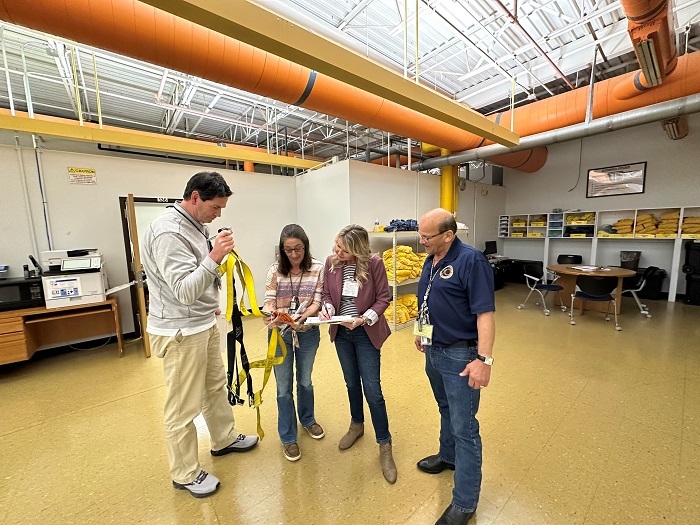 Students conduct the practical portion of the Site Specific Facility Inspection Training course as North Wind Dynamics United Steelworkers Worker-Trainer Melvin Fannin, far right, evaluates.
PIKE COUNTY, Ohio — The U.S. Department of Energy Office of Environmental Management’s Portsmouth Site recently partnered with a labor union to develop a course to enhance the safety and effectiveness of facility inspections across the site.
The joint effort between North Wind Dynamics (NWD), Portsmouth’s infrastructure support services contractor, and United Steelworkers (USW) resulted in the creation of the Site Specific Facility Inspection Training course, which is available to all site contractors.
“We believe this cooperative effort will not only enhance safety but promote a culture of continuous improvement and collaboration at the Portsmouth Site,” NWD Environmental, Safety, Health and Quality Manager Matt Miller said.
The collaboration combines NWD’s expertise in site-specific assessments and inspection protocols with USW’s valuable insights into the challenges and best practices of facility inspections.
By combining knowledge and resources, NWD and USW developed a comprehensive training course to address the specific needs and requirements of facility inspections. The collaborative approach ensures the training course is practical, relevant and tailored to the unique needs of Portsmouth Site employees.
“The class was highly enlightening,” training specialist and class participant Bernard Pertuset said. “It provided the necessary tools to be able to identify hazards that may have gone unnoticed.”
The course covers topics such as hazard identification, risk assessment, regulatory compliance and effective communication strategies.
-Contributor: Matthew Miller

WEST VALLEY, N.Y. – U.S. Department of Energy Office of Environmental Management (EM) crews at the West Valley Demonstration Project have safely removed sections of contaminated ventilation duct as part of ongoing demolition of the Main Plant Process Building.
The 26-inch-diameter duct had carried exhaust from past operations. It was located in the plant’s Vent Wash Room, a cell housing a ventilation "scrubber” that removed airborne particulates resulting from fuel reprocessing operations that ceased in 1972. The 19 sections of the duct were removed from that space during deactivation activities in 2021 and placed in another area of the plant so they could be taken out during the current demolition phase.
After removing the duct sections from the Vent Wash Room in 2021, crews removed debris, applied fixative to the cell, grouted the floor and placed the duct sections into containment bags to control contamination for removal.
 |
|
Crews use construction equipment to safely remove packaged ventilation duct sections from the Vent Wash Room as part of the demolition of the Main Plant Process Building at the West Valley Demonstration Project. |
EM and cleanup contractor CH2M HILL BWXT West Valley (CHBWV) incorporated feedback from workers that supported the safe deactivation of the Vent Wash Room. The workers proposed performing work remotely with a saw used to cut the ventilation duct to limit potential radiation exposure.
“Using lessons learned and a deliberate approach from previous demolition activities has been an excellent combination for safety and success,” said Stephen Bousquet, EM West Valley assistant director of Project Management. “Combining their expertise and communication skills helped to make this work evolution safe, smooth and compliant.”
CHBWV Facility Disposition Manager Tom Dogal reiterated Bousquet’s sentiment.
“Extensive planning, engineered controls and the right people allow us to perform our cleanup mission safely and compliantly,” Dogal said. “Teamwork and communication kept them focused on the task to ensure a smooth, deliberate and successful outcome.”
The Main Plant is one of the last major facilities at West Valley. Its successful demolition will further reduce environmental risks and position the site for the next phase in cleanup. The demolition is expected to be completed in fiscal year 2025, which begins this October.
-Contributor: Joseph Pillittere
 
MATTAWA, Wash. — One Hanford employees continue to do outreach in the community to inspire and support student interests in science, technology, engineering, and math fields. Volunteers partnered with staff from the Washington State STEM Education Foundation’s “STEM Like ME!” Program at Wahluke Junior High to engage students in related activities and discussions. Volunteers started with STEM subject-related icebreakers, discussing each student’s future career goals, and provided insights and guidance based on their own career experience.
One student interested in law had a change of heart after participating. The student expressed a newfound excitement for engineering, recognizing its appeal and potential for fun and creativity. The “STEM Like ME!” Program exemplifies the power of engagement in STEM, showing how exposure to these activities can inspire and redirect young minds towards exciting, fulfilling career paths in engineering and other related fields.

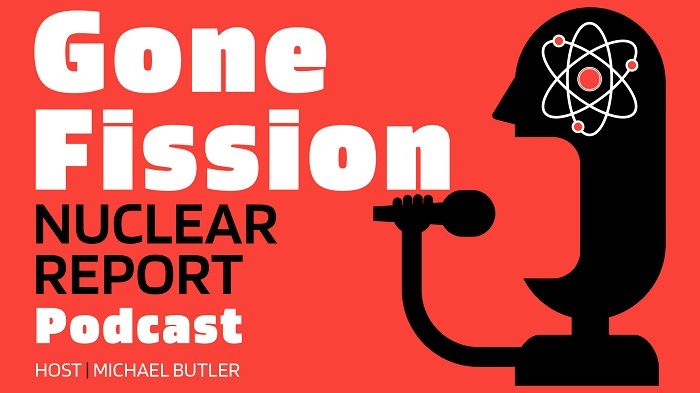 The U.S. Department of Energy Environmental Management Consolidated Business Center (EMCBC) is celebrating its 20th anniversary this year. Called the “Swiss Army knife of Environmental Management,” the center serves as a centralized hub for procurement, financial management and technical support for DOE’s Office of Environmental Management program. EMCBC oversees the cleanup of sites such as former nuclear production facilities, research laboratories and uranium mining sites. Click here for the “Gone Fission Nuclear Report Podcast” episode on EMCBC’s 20th anniversary, kicking off a yearlong anniversary celebration. Podcast host Michael Butler interviews EMCBC Deputy Director Melody Bell and Procurement Director Aaron Deckard.
 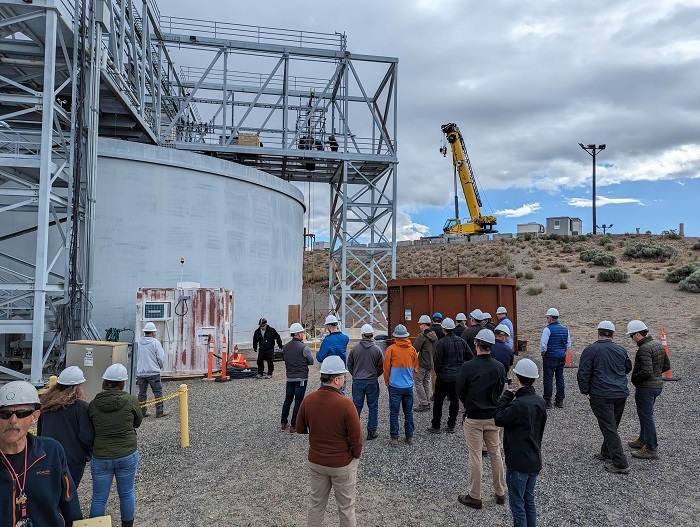 Workers at the Hanford Site recently demonstrated a “cold spray” technology for creating metal patches outside the simulated large waste tank at Hanford’s Cold Test Facility.
RICHLAND, Wash. ― The U.S. Department of Energy (DOE) Office of Environmental Management (EM) and contractor Washington River Protection Solutions (WRPS) recently demonstrated a potential new approach to refurbish double-shell tanks (DSTs) at the Hanford Site.
DSTs were constructed between 1968 and 1986 to hold waste transferred from aging single-shell tanks. These are large, underground tanks that consist of a primary carbon-steel tank inside a secondary carbon-steel liner, surrounded by a reinforced concrete shell. The tanks store waste created during Hanford’s plutonium production era. They support feeding the treated waste to Hanford’s low-activity waste vitrification facility at the Waste Treatment and Immobilization Plant. Vitrification is a process in which the waste is immobilized in glass.
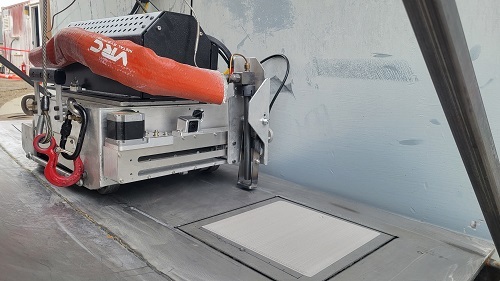 |
|
Operators remotely controlled a robot that used the cold spray technology to apply a metal patch on a simulated floor of the inner and outer shells of a Hanford double-shell tank. |
Crews used a technology known as “cold spray” that applies metal patches by shooting metal powder on a surface at supersonic speed, causing it to adhere to the surface without melting either material. While other industries use this technology, it had not been extensively evaluated for use at the Hanford Tank Farms.
“DOE is exploring potential refurbishment technologies that will extend the lifespan of Hanford’s large underground tanks in support of the tank waste mission, including the Direct-Feed Low-Activity Waste Program,” said Erik Nelson, EM technical lead for tank and pipeline integrity at Hanford.
WRPS, along with its partners, has spent three years developing a method to combine cold spray and robot technology to refurbish areas of DSTs.
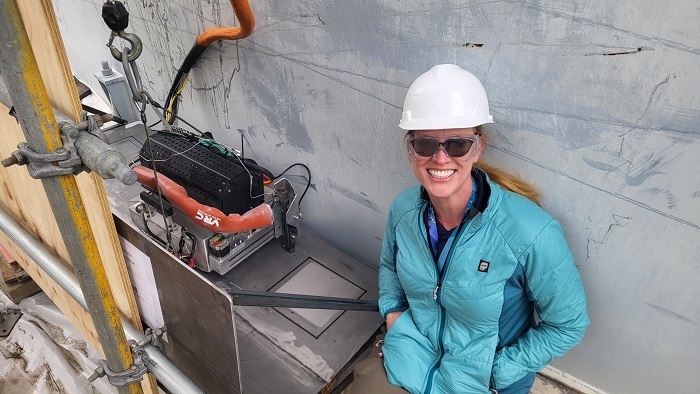 Stephanie Doll, Washington River Protection Solutions technical lead for tank refurbishment projects, poses next to the metal patch applied during the demonstration.
Previously, crews used mock-up demonstrations at Hanford’s Cold Test Facility to show that robotic equipment can be lowered into the space between the first and second shell of a DST, known as the annulus, to navigate the space. Crews recently demonstrated that robots equipped with the cold spray technology can also refurbish a mock annulus floor.
“I’m impressed with cold spray technology and its potential application for the Hanford double-shell tanks, based on data we’ve gathered during full-scale demonstrations,” said Stephanie Doll, WRPS technical lead for tank refurbishment projects. “The field crew involved in deploying and operating the equipment is equally as impressive. Their invaluable feedback and proficiency have been key to our success so far.”
The recent demonstration validated the system’s capabilities, and the team’s progress brings the technology a step closer to potentially joining Hanford’s’ tank integrity toolkit.
 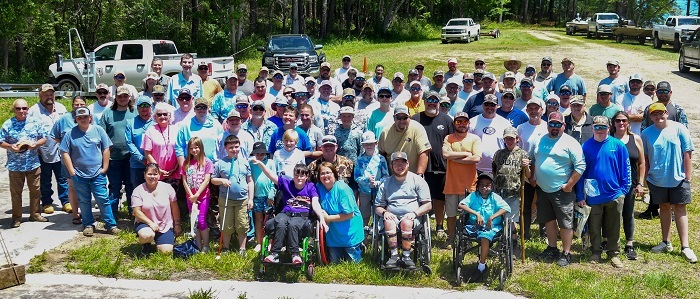 Ultimate Bass Challenge participants gather for a group photo at the conclusion of the day’s events. Image courtesy of Roger Metz.
NEW ELLENTON, S.C. — Getting up before dawn and heading out on the water at sunrise was worth the effort for contestants during the recent Outdoor Dream Foundation Ultimate Bass Challenge fishing event on the Savannah River Site (SRS).
The 25 participants and their escorts brought more than fish back to the docks for weigh-in; they returned to shore with a sense of accomplishment.
For one lucky contestant, winning was made more special by bringing in the heaviest catch for the two-fish-limit catch-and-release tournament. With a two-fish weight of 11.75 pounds, Brogan Fairchild and escort Brooke Bryan took top honors. John Lajoie and escort David Smith caught the largest fish that day, at 6.95 pounds.
Fishing on SRS isn’t new. For the past eight years the U.S. Department of Energy – Savannah River Site, U.S. Forest Service and National Wild Turkey Federation have partnered to host fishing events for injured veterans, mobility challenged or disabled individuals, and most recently, first responders.
But fishing events with new partner Outdoor Dream Foundation are just a bit more special.
“Getting these kids with life-threatening conditions out on the water is what makes this day truly special for everyone involved,” said Thomas “Tal” Mims, senior wildlife biologist with the U.S. Forest Service - Savannah River and event organizer. “People often take simple things like fishing for granted. Seeing these kids’ smiles and hearing the stories they tell about being on the water and fishing, it’s why we do events like this.”
Events such as the bass challenge and spring turkey hunt that occurred earlier this year on the site aren’t just recreation events. They are also an important tool used by natural resource and environmental managers and research staff to gauge the health of forests and waterways on SRS. Records of fish weights and wildlife measurements caught at these events give managers and research staff the ability to identify health trends of certain indicator species across such a large, forested area. Trending information offers the insight needed to develop future management actions to improve the health and diversity of forests and waterways on the site.
-Contributor: Josef Orosz
|






